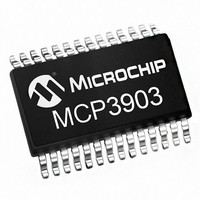MCP3903-I/SS Microchip Technology, MCP3903-I/SS Datasheet - Page 19

MCP3903-I/SS
Manufacturer Part Number
MCP3903-I/SS
Description
IC AFE 24BIT 64KSPS 28SSOP
Manufacturer
Microchip Technology
Series
-r
Datasheet
1.MCP3903-ISS.pdf
(54 pages)
Specifications of MCP3903-I/SS
Featured Product
MCP3903 Six Channel ÎΣ A/D Converter
Number Of Bits
24
Number Of Channels
6
Power (watts)
-
Voltage - Supply, Analog
4.5 V ~ 5.5 V
Voltage - Supply, Digital
2.7 V ~ 3.6 V
Package / Case
28-SSOP (0.209", 5.30mm Width)
Lead Free Status / Rohs Status
Lead free / RoHS Compliant
Available stocks
Company
Part Number
Manufacturer
Quantity
Price
Company:
Part Number:
MCP3903-I/SS
Manufacturer:
Microchip
Quantity:
263
Part Number:
MCP3903-I/SS
Manufacturer:
MICROCHIP/微芯
Quantity:
20 000
4.8
Integral non-linearity error is the maximum deviation of
an ADC transition point from the corresponding point of
an ideal transfer function, with the offset and gain
errors removed, or with the end points equal to zero.
It is the maximum remaining error after calibration of
offset and gain errors for a DC input signal.
4.9
For the MCP3903 ADC, the signal-to-noise ratio is a
ratio of the output fundamental signal power to the
noise power (not including the harmonics of the signal),
when the input is a sinewave at a predetermined
frequency. It is measured in dB. Usually, only the
maximum signal to noise ratio is specified. The SNR
figure depends mainly on the OSR and DITHER
settings of the device.
EQUATION 4-4:
4.10
The most important figure of merit for the analog
performance of the ADCs present on the MCP3903 is
the
specification.
Signal-to-noise and distortion ratio is similar to signal-
to-noise ratio, with the exception that you must include
the harmonics power in the noise power calculation.
The SINAD specification depends mainly on the OSR
and DITHER settings.
EQUATION 4-5:
The calculated combination of SNR and THD per the
following formula also yields SINAD:
EQUATION 4-6:
© 2011 Microchip Technology Inc.
SINAD dB
SINAD dB
Signal-to-Noise
SNR dB
Integral Non-Linearity Error
Signal-To-Noise Ratio (SNR)
Signal-To-Noise Ratio And
Distortion (SINAD)
(
(
(
)
=
)
)
10
=
=
log
10
10
SIGNAL-TO-NOISE RATIO
SINAD EQUATION
SINAD, THD, AND SNR
RELATIONSHIP
⎛
⎝
log
log
------------------------------------------------------------------- -
Noise
And
⎛
⎝
SignalPower
--------------------------------- -
10
NoisePower
⎛
⎝
+
SignalPower
SNR
---------- -
10
HarmonicsPower
Distortion
⎞
⎠
+
10
⎛
⎝
⎞
⎠
–
--------------- -
THD
10
(SINAD)
⎞
⎠
⎞
⎠
4.11
The total harmonic distortion is the ratio of the output
harmonics power to the fundamental signal power for a
sinewave input and is defined by the following
equation.
EQUATION 4-7:
The THD calculation includes the first 35 harmonics for
the MCP3903 specifications. The THD is usually only
measured with respect to the 10 first harmonics. THD
is sometimes expressed in %. For converting the THD
in %, here is the formula:
EQUATION 4-8:
This specification depends mainly on the DITHER
setting.
4.12
SFDR is the ratio between the output power of the
fundamental and the highest spur in the frequency
spectrum. The spur frequency is not necessarily a
harmonic of the fundamental even though it is usually
the case. This figure represents the dynamic range of
the ADC when a full-scale signal is used at the input.
This specification depends mainly on the DITHER
setting.
EQUATION 4-9:
THD dB
SFDR dB
Total Harmonic Distortion (THD)
(SFDR)
Spurious-Free Dynamic Range
(
(
THD %
)
=
)
=
( )
10
10
log
=
log
⎛
⎝
---------------------------------------------------- -
FundamentalPower
100 10
⎛
⎝
HarmonicsPower
FundamentalPower
---------------------------------------------------- -
HighestSpurPower
×
MCP3903
THD dB
------------------------
20
DS25048B-page 19
(
)
⎞
⎠
⎞
⎠














